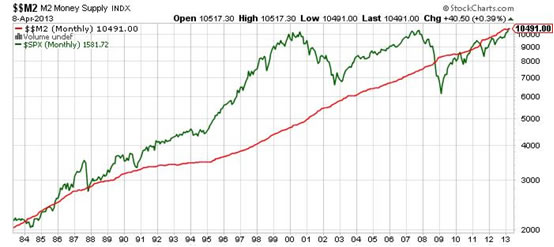Stock Market Will Crash When Central Banks Stop Printing
Stock-Markets / Financial Crash May 03, 2013 - 12:10 PM GMTBy: DailyGainsLetter
 Moe Zulfiqar writes: As central banks around the world have taken money printing and easy monetary policy, such as low interest rates, as their key tools to boost economic growth, there are concerns among investors about what happens once they actually stop and bring their monetary policy back towards normalization—raising interest rates and no longer printing money like they are doing now.
Moe Zulfiqar writes: As central banks around the world have taken money printing and easy monetary policy, such as low interest rates, as their key tools to boost economic growth, there are concerns among investors about what happens once they actually stop and bring their monetary policy back towards normalization—raising interest rates and no longer printing money like they are doing now.
For example, the Federal Reserve is printing $85.0 billion a month, and its balance sheet has already ballooned more than $3.0 trillion after the financial crisis brought the U.S. financial system to near collapse. On top of all this, the Fed is also keeping interest rates near zero. Similarly, the Bank of Japan is taking the same measures and plans to increase its money supply extensively.
Looking at all this; there is a notion among investors that the stock markets are currently going higher because the central banks are printing money—not because of real reasons, such as earnings growth. When the economy is flooded with money, it usually has to find a home; the money is flowing into the stock market. Once they start normalizing their monetary policy, the stock market may come crashing down.
This opens the floor to debate; does money supply actually dictate the direction of the stock market? Please look at the chart below:

Chart courtesy of www.StockCharts.com
The chart above consists of the U.S. M2 money supply and the S&P 500.
Before going into further details, readers should know that the M2 money supply is a broad measure of money in an economy. In addition to currency in circulation (coins and notes), M2 also includes the amount of money in savings accounts and other related accounts. This measure of money is used by economists to get a more precise idea of the money supply in a country.
Go back to the chart above; looking at the overall picture, it indicates that as the money supply has increased (red line), the stock market/S&P 500 (green line) has followed the same direction. Just by observing this phenomenon, is this enough reason to believe the stock market will head lower once the central banks stop printing money and raise interest rates?
After paying close attention, you will notice that from the beginning of 1984 to 2000, the M2 and the S&P 500 moved in a similar direction. They both trended higher, but after 2000, things changed; as the money supply continued to increase, the S&P 500 didn’t trend higher, contrary to what investors believe. It traded sideways instead.
Saying rigorous printing and low interest rates were the only cause of the rise in the stock market may be faulty, but this by no means suggests that they didn’t have any implications on the stock market at all. Consider this: if the money printing continues, the value of the currency declines, causing the asset prices to rise.
There are many factors that affect the stock market other than just money supply. Looking at the performance of the S&P 500; the main reason for the rise in the stock market may be because economic conditions are much better than they were during the financial crisis: the unemployment rate is much lower, Americans are spending, and the financial system is in much better shape than before.
Source: http://www.dailygainsletter.com/stock-market/...
Copyright © 2013 Daily Gains Letter – All Rights Reserved
Bio: The Daily Gains Letter provides independent and unbiased research. Our goal at the Daily Gains Letter is to provide our readership with personal wealth guidance, money management and investment strategies to help our readers make more money from their investments.
© 2005-2022 http://www.MarketOracle.co.uk - The Market Oracle is a FREE Daily Financial Markets Analysis & Forecasting online publication.



